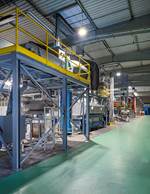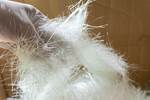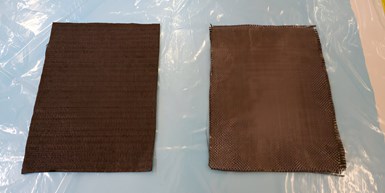UNSW Canberra develops carbon fiber recycling method
New research indicates that novel recycling method only degrades carbon fibers by 30% versus 80-90%, targets use for automotive applications.

UNSW Canberra researcher Di He with a sample of carbon fiber recycled using a method he developed. Photo Credit, all images: UNSW Canberra
Universty of South Wales (UNSW, Australia) Canberra researcher Dr. Di He has developed a method to recycle carbon fiber in a way that not only means less of the material is wasted, but also uses less energy and leaves more of it intact and able to be turned into more useful new products.
The project was a collaboration with a UNSW Canberra partner in the automotive industry who wanted to investigate building cars out of recycled carbon fiber. He notes that, until now, recycling carbon fiber had always resulted in the material being heavily degraded.
“With the previous methods of recycling carbon fiber, the material was heavily compromised,” He explains. “The mechanical performance of objects made from the existing recycled fibers is degraded by 80-90%, compared to using new fibers. Typically, it is only reused to make low-value products like tables or chairs, products that don’t experience heavy forces or loads.”
Some existing recycling methods involve shredding the composite, which destroys the carbon fiber, before heating it to remove the plastic. After it has been shredded, the fibers look like individual hairs or cotton wool strands.
Carbon fiber recycled using the old method (left) compared with Dr. He's new method (right). The recycled carbon fibr on the right is stronger and has the potential to be turned into more advanced products.
“In our method we don’t shred the carbon fiber and we optimized how we heat it in a furnace,” He says.“Our method degrades the carbon fiber by less than 30%, which is a 50% improvement on existing methods.” While the recycled carbon fiber produced using He’s method is not yet able to be used to construct a car, it is reported to be significantly closer to that goal than before; the new and improved recycled carbon fiber can potentially be used to construct individual parts of a car, such as a roof.
One of the lead researchers from the UNSW Canberra Advanced Manufacturing Research Group, associate professor Matthew Doolan, says that as the world progresses with engineering and technological advancements, it needs to think more about reducing waste.
“As we make more advanced products we also make them from significantly more advanced materials, and as a result we are creating problems at the end of the life of that product,” Doolan says. “The standard practice of just dumping these products, or burning them, is unsustainable and cannot continue forever. Exploring other options available to us is one of the key questions we’re hoping to help answer at UNSW Canberra.”
He and Doolan, along with their collaborators, recently published their findings regarding recycling carbon fibre in the journal Composites Part A: Applied Science and Manufacturing. Read more about their findings here.
Related Content
-
Prepreg compression molding supports higher-rate propeller manufacturing
To meet increasing UAV market demands, Mejzlik Propellers has added a higher-rate compression molding line to its custom CFRP propeller capabilities.
-
Aerospace prepregs with braided reinforcement demonstrate improved production rates, cost
A recent time study compares the layup of a wing spar using prepreg with A&P’s TX-45 continuous braided reinforcement versus traditional twill woven prepreg.
-
Plant tour: Teijin Carbon America Inc., Greenwood, S.C., U.S.
In 2018, Teijin broke ground on a facility that is reportedly the largest capacity carbon fiber line currently in existence. The line has been fully functional for nearly two years and has plenty of room for expansion.
















